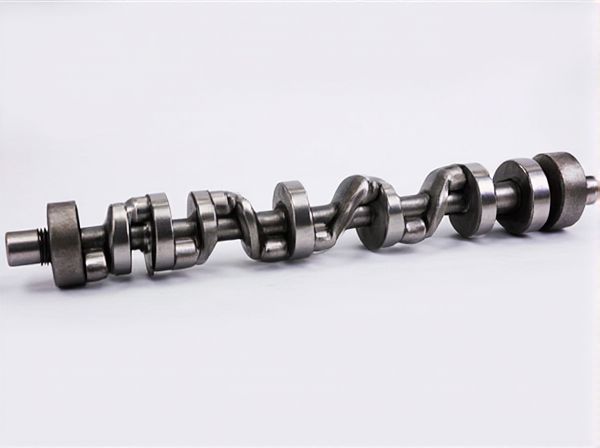
Photo illustration: Internal vs External Balanced Crankshaft
An internal balanced crankshaft maintains its balance through counterweights integrated within the crankshaft itself, reducing the need for external balancing components. External balanced crankshafts rely on additional weights attached outside the crankshaft to achieve optimum rotational stability. Understanding these differences helps you choose the best crankshaft design for engine performance and durability.
Table of Comparison
| Feature | Internal Balanced Crankshaft | External Balanced Crankshaft |
|---|---|---|
| Balance Mechanism | Counterweights are integrated within the crankshaft | Balance weights added externally on the flywheel or harmonic balancer |
| Installation | Requires specific crankshaft design, simpler installation of rotating assembly | Standard crankshaft with added external balance components |
| Maintenance | Lower maintenance; fewer external parts to wear | Higher maintenance due to external weights and components |
| Performance | Smoother engine operation, reduced vibration inside the engine block | Can cause vibrations if external weights are out of balance |
| Durability | Higher durability due to fewer external parts | Potential for wear and damage on external balancing components |
| Use Cases | Common in high-performance and racing engines | Often used in standard production engines |
Introduction to Crankshaft Balancing
Crankshaft balancing is crucial for engine smoothness and longevity, minimizing vibrations caused by rotating and reciprocating masses. Internal balanced crankshafts incorporate counterweights within the crankshaft itself, providing balance without extra components, enhancing compactness and reliability. External balanced crankshafts use additional weights on the flywheel or harmonic balancer, offering easier adjustment but potentially increasing wear and complexity.
What is an Internal Balanced Crankshaft?
An internal balanced crankshaft incorporates counterweights integrated within the crankshaft structure to offset rotational forces, reducing vibration and enhancing engine smoothness. This design eliminates the need for additional external balancing components on the flywheel or harmonic balancer, simplifying assembly and maintaining compact engine dimensions. Internal balancing optimizes engine performance by minimizing stress on bearings and improving overall durability.
What is an External Balanced Crankshaft?
An external balanced crankshaft uses weights added outside the crankshaft to counteract engine vibrations and improve rotational stability. This design allows for easier adjustments and customization during engine tuning without modifying the crankshaft itself. External balancing is commonly used in high-performance and racing engines to optimize balance and reduce harmful vibrations.
Key Differences Between Internal and External Balancing
Internal balancing involves adding counterweights integrated within the crankshaft itself, resulting in a more compact design that reduces vibration directly at the source. External balancing requires weights added to the harmonic balancer, flywheel, or pulley, allowing easier adjustments but potentially increasing rotational inertia. The key differences between internal and external balancing lie in installation complexity, weight distribution precision, and impact on engine performance and smoothness.
Pros and Cons of Internal Balanced Crankshafts
Internal balanced crankshafts feature counterweights integrated within the crankshaft structure, improving rotational stability and reducing vibration. This design enhances engine smoothness and longevity by minimizing stress on crankshaft bearings but may increase manufacturing complexity and cost. Internal balancing allows for better packaging in compact engine bays compared to external balanced crankshafts that add weight externally.
Pros and Cons of External Balanced Crankshafts
External balanced crankshafts offer improved vibration control by allowing balance weights to be placed outside the crankshaft, reducing torsional stress on internal engine components and enhancing durability. Their design facilitates easier customization for high-performance applications, while potentially increasing engine weight and complexity due to added external components. However, external balancing can lead to slight increases in rotational inertia, which might marginally affect engine responsiveness compared to internal balancing methods.
Performance Impact: Internal vs External Balanced Crankshaft
Internal balanced crankshafts improve engine performance by reducing torsional vibrations directly within the crankshaft, leading to smoother operation and increased durability. External balanced crankshafts compensate for imbalances through added weights or harmonic balancers outside the crankshaft, which can slightly increase rotational inertia and reduce peak engine responsiveness. Choosing an internal balanced crankshaft often results in more precise engine tuning and higher RPM capabilities compared to external balancing methods.
Engine Applications and Suitability
Internal balanced crankshafts are ideal for high-performance engines requiring precise balance and reduced vibration, commonly found in sports cars and racing engines to enhance acceleration and durability. External balanced crankshafts suit larger displacement engines, including trucks and heavy-duty applications, where added counterweights accommodate aftermarket modifications and accessories. Selecting between internal and external balance depends on engine size, performance goals, and compatibility with the engine block design.
Maintenance and Reliability Considerations
Internal balanced crankshafts offer improved durability by reducing vibrations within the engine, resulting in lower wear on bearings and seals, thus requiring less frequent maintenance. External balanced crankshafts, while easier to service due to accessible balance weights, may experience increased stress on the crankshaft and associated components, leading to higher long-term maintenance demands. Reliability in internal balancing systems typically surpasses external ones due to enhanced structural integrity and reduced risk of balance weight detachment during operation.
Choosing the Right Crankshaft Balancing for Your Engine
Selecting the right crankshaft balancing depends on engine design and performance requirements; internal balanced crankshafts integrate their counterweights within the crankshaft, offering compactness and smoother operation ideal for smaller or naturally aspirated engines. External balanced crankshafts require additional counterweights attached outside the crankshaft, providing greater flexibility for high-performance and modified engines with heavy rotating assemblies. Understanding the engine's balance type ensures optimal vibration control, longevity, and efficiency tailored to specific automotive applications.
 caratoz.com
caratoz.com